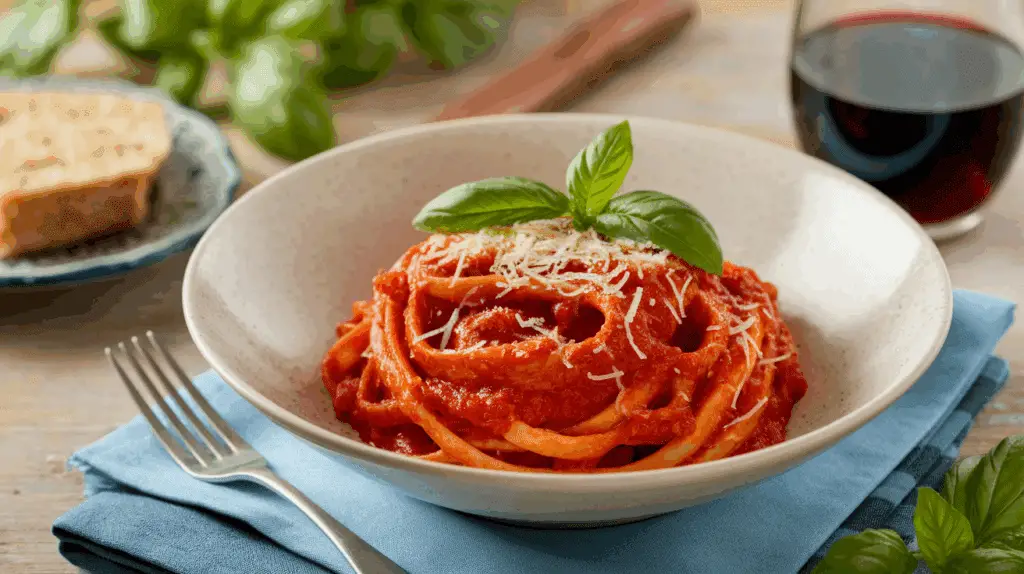Alright, my fellow food lover, let’s talk about red sauce pasta. It’s the ultimate comfort food, isn’t it? The kind of dish that warms your soul, conjures up images of bustling Italian kitchens, and always hits the spot. You’ve probably ordered it countless times at restaurants, or maybe you whip it up often at home with a jarred sauce and call it a day. But have you ever truly mastered the art of homemade red sauce pasta, where the sauce clings perfectly to every noodle, and each bite bursts with fresh, vibrant flavor? My early attempts often resulted in watery sauce sliding off limp pasta, leaving me wondering why my “easy dinner” felt so lackluster. Sigh. But I’ve learned the secrets, battled the soggy noodles, and discovered that how to make red sauce pasta that tastes truly authentic and incredibly satisfying is within every home cook’s reach. If you’re ready to ditch the dull dinners and dive into a bowl of pure Italian comfort, then grab your biggest pot. We’re about to make some pasta magic!
Why Homemade Red Sauce Pasta? Beyond Just a Quick Meal!
Why bother making red sauce pasta from scratch when you can just boil some noodles and open a jar? Oh, my friend, that’s like comparing a simple sketch to a masterpiece! The difference in flavor, texture, and pure satisfaction is monumental.
Here’s why I’m a passionate advocate for homemade red sauce pasta:
- Unbeatable Fresh Flavor: This is the absolute biggest reason. Homemade red sauce pasta, built from fresh ingredients, tastes miles ahead of any jarred sauce. It’s vibrant, nuanced, and utterly delicious.
- You Control the Ingredients: Say goodbye to added sugars, preservatives, or questionable oils often found in commercial sauces. You choose exactly what goes into your meal.
- Perfectly Cooked Pasta: When you make it yourself, you ensure your pasta is cooked to that glorious “al dente” perfection, which is crucial for texture and flavor absorption.
- Infinitely Customizable: Want it spicy? Load it with chili flakes! Craving a richer sauce? Add some ground meat. Need more veggies? Throw them in! You’re the master chef of your own pasta destiny.
- Therapeutic & Rewarding: There’s a profound satisfaction that comes from creating a truly delicious meal from scratch. The aroma filling your kitchen is a bonus! IMO, it’s a truly comforting culinary experience.
The Building Blocks: Essential Ingredients for Stellar Red Sauce Pasta
Great red sauce pasta starts with great ingredients. Focus on quality, and the rest will follow.
The Pasta: Your Noodle Navigator
The right pasta shape can make all the difference in how your sauce clings!
- Dry Pasta: High-quality dry pasta made from durum wheat semolina is excellent. It holds its shape and texture well.
- Shape Matters:
- Long Pastas (Spaghetti, Linguine, Fettuccine): Ideal for thinner, smoother sauces that cling to the strands.
- Short Pastas (Penne, Rigatoni, Farfalle): Great for chunkier sauces with vegetables or meat, as the sauce gets trapped in the tubes or crevices.
- Fresh Pasta (Optional): Fresh pasta offers a softer, more delicate texture and cooks very quickly. Pair it with lighter sauces.
Tomatoes: The Heart of the Red Sauce
Just like with marinara, tomato quality is paramount here.
- Canned Whole Peeled San Marzano Tomatoes: These are the gold standard for Italian red sauce. They have a fantastic balance of sweetness and acidity, a beautiful color, and break down wonderfully. Crush them by hand directly into the pot for the best texture.
- Canned Crushed Tomatoes: A good alternative if you want a slightly smoother sauce with less effort.
- Tomato Paste: A small spoon of tomato paste can add a concentrated depth of flavor and richness to your sauce. Sauté it with the aromatics.
Aromatics: Garlic, Onion, and Flavor Magic
These build the foundational flavor of your sauce.
- Fresh Garlic: Non-negotiable! Use plenty, minced or thinly sliced. It adds pungent warmth. I typically use 4-6 cloves of garlic per 28-ounce can of tomatoes.
- Yellow Onion (or Shallots): Finely diced. Cook gently until translucent and sweet. It adds a subtle sweetness and depth.
Olive Oil: The Italian Gold
- Extra Virgin Olive Oil: Use a good quality extra virgin olive oil. It serves as your cooking fat and contributes to the overall flavor of the sauce.
Herbs & Seasoning: The Soul of the Sauce
These elevate your sauce from good to unforgettable.
- Fresh Basil: Essential for that classic Italian flavor. Add it towards the end of cooking to preserve its delicate aroma.
- Dried Oregano: A pinch of dried oregano (especially Mediterranean oregano) adds an earthy, classic Italian touch. Add this earlier in the cooking process.
- Red Pepper Flakes (Optional): For a touch of heat, add these with your aromatics.
- Salt & Freshly Ground Black Pepper: Season throughout the process, adjusting to taste at the end.
- Sugar (Optional): A tiny pinch of granulated sugar (1/2 teaspoon per can) or a small amount of grated carrot can balance the acidity of some tomatoes if needed.
Essential Equipment: You’ve Got This!
You don’t need a professional kitchen setup, just a few key items.
- Large Pot for Pasta: Essential for cooking pasta in plenty of water so it cooks evenly and doesn’t stick.
- Heavy-Bottomed Pot or Dutch Oven: For making the sauce. A heavy bottom ensures even heat distribution and prevents scorching.
- Colander: For draining cooked pasta.
- Wooden Spoon or Sturdy Spatula: For stirring sauce.
- Tongs: For tossing pasta.
Part 1: Crafting Your Red Sauce – The Foundation of Flavor
This is where your delicious journey begins! Focus on building layers of flavor.
Sautéing Aromatics: Building the Base
- Heat 2-3 tablespoons of olive oil in your heavy-bottomed pot over medium-low heat.
- Add your finely diced onion (if using) and cook gently until translucent and softened, about 5-7 minutes. Don’t let it brown, as we want sweet, mellow onion flavor.
- Add the minced garlic (and red pepper flakes/dried oregano if using) and cook for another 1-2 minutes, stirring constantly. Do not let the garlic burn! Burnt garlic turns bitter and will ruin your sauce. You want it fragrant and just starting to turn golden.
- Stir in 1 tablespoon of tomato paste (if using) and cook for 1 minute, stirring, to deepen its flavor.
Adding Tomatoes & Simmering: The Slow Dance
- If using whole peeled tomatoes, carefully crush them by hand directly into the pot.
- Add the crushed tomatoes (or canned crushed tomatoes) to the pot.
- Add a pinch of salt and pepper. If your tomatoes seem acidic, add a tiny pinch of sugar.
- Bring the sauce to a gentle simmer, then reduce the heat to low.
- Cover the pot partially (leaving a small gap for steam to escape) and simmer for at least 30-45 minutes. Simmering longer, even up to an hour or two, develops deeper flavors and allows the tomatoes to break down. Stir occasionally to prevent sticking.
Finishing & Seasoning: The Final Flourish
- Remove the sauce from the heat.
- Stir in a generous handful of fresh basil leaves, roughly torn or chopped. The residual heat will wilt them and release their aroma.
- Taste the sauce. Adjust salt and pepper as needed. Does it need a tiny pinch more sugar to balance acidity? This is your last chance for perfection!
Part 2: Cooking the Pasta – Al Dente Perfection
Perfect pasta is just as important as perfect sauce!
Pick Your Shape: Pasta Personalities
Choose a pasta shape that complements your sauce and how you plan to eat it. Make sure you match sauce consistency to the pasta shape for optimal clinging.
The Golden Rule: Salt Your Water!
- Fill your large pot with plenty of water. You need about 4-6 quarts (liters) of water per pound of pasta to allow it to move freely.
- Bring the water to a rolling boil.
- Add a generous amount of salt to the boiling water. This is crucial for flavoring the pasta itself, as pasta absorbs salt from the water. It should taste like the sea, or at least a very salty soup. About 1-2 tablespoons of kosher salt per gallon of water is a good rule of thumb.
Boiling to Al Dente: The Perfect Bite
- Add your pasta to the boiling, salted water. Stir immediately to prevent sticking.
- Cook according to package directions, but always check for al dente by tasting a piece a minute or two before the suggested cook time. Al dente means “to the tooth” – it should be firm to the bite, not hard or mushy.
- Do not overcook! Overcooked pasta is soggy and sad.
Reserve That Pasta Water: Your Secret Weapon
This is a pro tip that truly elevates your pasta dishes.
- Before draining the pasta, reserve about 1-2 cups of the starchy pasta cooking water. That starchy, salty liquid is liquid gold! It helps emulsify the sauce and create a silky, cohesive coating for your pasta.
Part 3: Bringing It All Together – The Grand Finale!
This is where the magic happens – marrying the sauce and the pasta!
Marrying Sauce and Pasta: A Match Made in Heaven
- Once your pasta is al dente, drain it quickly (do not rinse it!) and immediately transfer it to your pot of simmering red sauce.
The Pan Finish: Coating Every Strand
- Toss the pasta and sauce together vigorously.
- Add a splash (1/4 to 1/2 cup) of your reserved pasta water to the sauce. Continue tossing over medium heat for 1-2 minutes. The starch from the pasta water will help the sauce emulsify and cling beautifully to every strand, creating a cohesive, restaurant-quality dish. This is where the sauce truly becomes “one” with the pasta.
- The sauce will thicken slightly and become glossy.
Garnish & Serve: The Final Touch
- Remove from heat.
- Serve immediately in warm bowls.
- Garnish with freshly grated Parmesan cheese and fresh basil leaves. A drizzle of good quality olive oil can also add a nice finish. Pure perfection!
Flavor Explorations: Beyond the Basic Red Sauce Pasta
Once you master the basic red sauce pasta, you can easily customize it!
Spicy Kicks: A Little Heat Never Hurt
- Add more red pepper flakes to the sauce, or a drizzle of your favorite chili oil at the end.
Meaty Marvels: Beef, Sausage, or Meatballs
- Brown ground beef, Italian sausage, or make your favorite meatballs. Add them to the sauce during the simmering stage to meld flavors.
Creamy Dreamy Textures
- Stir in a splash of heavy cream (1/4 to 1/2 cup per can of tomatoes) at the very end of cooking the sauce for a luscious, creamy pink sauce.
- A dollop of ricotta cheese swirled into individual servings is also divine.
Veggie-Packed Powerhouses
- Sauté finely diced carrots, bell peppers, zucchini, or mushrooms with the onions and garlic for an extra dose of nutrients and texture.
Cheesy Indulgences
- Stir in a handful of shredded mozzarella or a different type of grated hard cheese (like Pecorino Romano) along with the Parmesan when serving.
Troubleshooting Red Sauce Pasta Pitfalls
Even simple dishes can have their moments. Don’t worry, we’ve all been there!
- Soggy Pasta:
- Solution: You overcooked it! Always cook pasta to al dente (check a minute or two before package directions). Also, ensure you cook it in plenty of boiling, salted water.
- Dry Sauce/Not Clinging:
- Solution: You didn’t add enough liquid, or you didn’t finish the pasta in the sauce with reserved pasta water. That starchy pasta water is key for adhesion!
- Bland Sauce:
- Solution: Not enough salt! Taste and adjust. Or perhaps your tomatoes weren’t high quality. Ensure your aromatics are properly cooked (not burnt, not raw).
- Sauce is Too Acidic:
- Solution: Add a small pinch of sugar or a tiny pinch of baking soda to neutralize. Simmer longer. Use good quality tomatoes.
- Burnt Garlic/Onion in Sauce:
- Solution: Heat was too high, or you didn’t stir enough. Cook aromatics on medium-low heat, stirring frequently. If it’s burnt, honestly, it’s best to start over.
Frequently Asked Questions
- What are the main ingredients for red sauce pasta? The main ingredients for a basic red sauce pasta include pasta, canned tomatoes (preferably San Marzano), olive oil, garlic, onion (optional), fresh basil, and salt. You can then add meat, other vegetables, or cream for variations.
- How do you get red sauce to stick to pasta? To get red sauce to stick to pasta, always finish cooking the al dente pasta directly in the simmering sauce for 1-2 minutes. Crucially, add a splash (1/4 to 1/2 cup) of reserved starchy pasta cooking water to the sauce as you toss. The starch in the water helps emulsify the sauce, allowing it to cling beautifully to the noodles.
- What kind of tomatoes are best for red sauce pasta? Canned whole peeled San Marzano tomatoes are widely considered the best for red sauce pasta. They offer a superior balance of sweetness and acidity, a vibrant color, and break down easily to create a rich, flavorful sauce.
- How long should red sauce simmer for pasta? Red sauce should simmer for at least 30-45 minutes to allow flavors to meld and deepen. However, simmering it for an hour or even two over low heat can develop an even richer, more complex taste and thicker consistency.
- Do you rinse pasta after cooking for red sauce pasta? No, you should never rinse pasta after cooking for red sauce pasta. Rinsing removes the starchy coating on the noodles, which is essential for helping the sauce cling to the pasta. Simply drain the pasta quickly and transfer it directly to the sauce.
- What does “al dente” mean for pasta? “Al dente” is an Italian term meaning “to the tooth.” For pasta, it means it should be cooked to be firm, but still tender, with a slight bite or resistance when you chew it. It should not be hard in the center, nor mushy.
- Can I add meat to a red sauce pasta recipe? Yes, you can easily add meat to a red sauce pasta recipe. Brown ground beef, Italian sausage, or make meatballs separately, then add them to the simmering red sauce to cook through and meld flavors. This turns it into a meat sauce or ragu.
Conclusion
So there you have it, my friend! The complete guide on how to make red sauce pasta that tastes like it came straight from a nonna’s kitchen. No more watery disappointments or bland dinners. You now possess the knowledge to create vibrant, perfectly coated, and incredibly satisfying pasta dishes every single time. Embrace the simplicity, savor the process, and get ready to impress yourself (and anyone lucky enough to share a meal with you!). You’ve totally got this! 🍝🍅🧀



